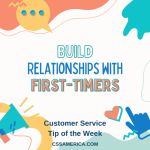We used to lease office space at an executive office suite. This was a national company, and when you lease from them, you get a fully furnished office, phone and mail service, and staff available to help with projects. And while the office suite had a great location and beautiful furnishings, there was always something wrong with it.
We have many projects where we need support – keying data, making calls, assembling information for mailings, etc. And it seemed like every time we asked for support (support that we paid an hourly fee to receive), we got pushback, delays, apathetic attitudes, or poor/incomplete work.
It was SO frustrating. This service could have been great for us and for them – great for us in that we only paid for the labor time when we needed it, flexing up and down as the workload fluctuated. It was great for them in that they earned more money. We were being provided with poor customer service, and to make matters worse, their call handling began to fade. They would misroute calls that should have been sent to our office or patched through to our cell phones.
In short, we left.
We interviewed several other executive office suite companies, and settled on Office Suites Plus (www.officesuitesplus.com) – where we’ve been 7 years in Charlotte, NC. All that the other place wasn’t, Office Suites Plus is; they love the projects, they constantly smile, they handle the calls and requests effortlessly, and – if there is an occasional error – they apologize, and we move on.
But one of the best aspects of Office Suites Plus is that when staff turnover happens, they always seem to find someone with a great attitude. You might say they have a gift of hiring people who are not only pleasant but who WANT to help you, who WANT to make sure you have a good experience. But I’ve been in business long enough to know it’s not a gift – it’s an intention.
To consistently hire good people who do good work with good attitudes and who understand what good customer service is all about, a company must WANT those qualities and look for those qualities in the first place.
You need to WANT to deliver good customer service to consistently succeed.
Interested in improving your company’s customer service? See more information at: http://www.cssamerica.com/





















